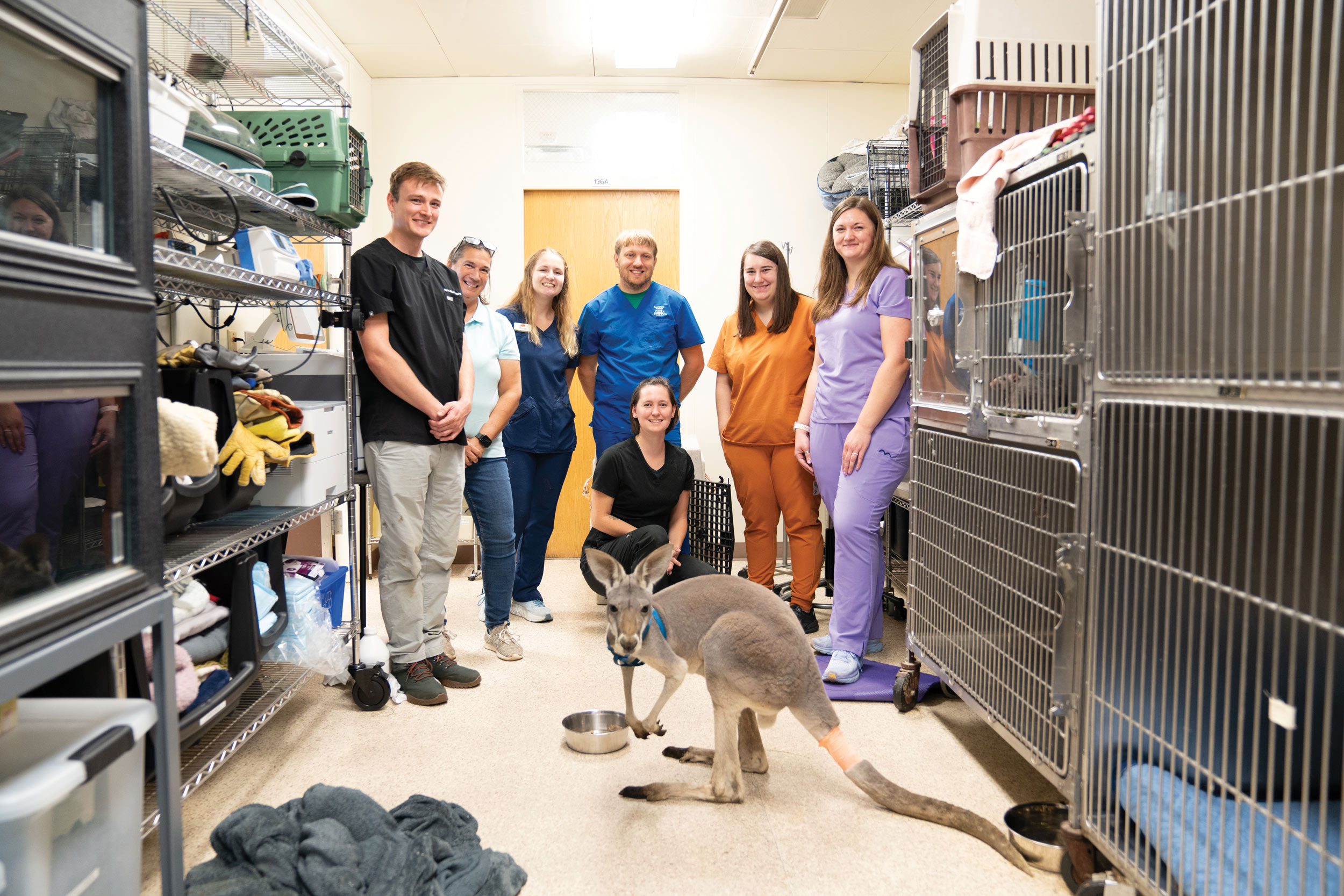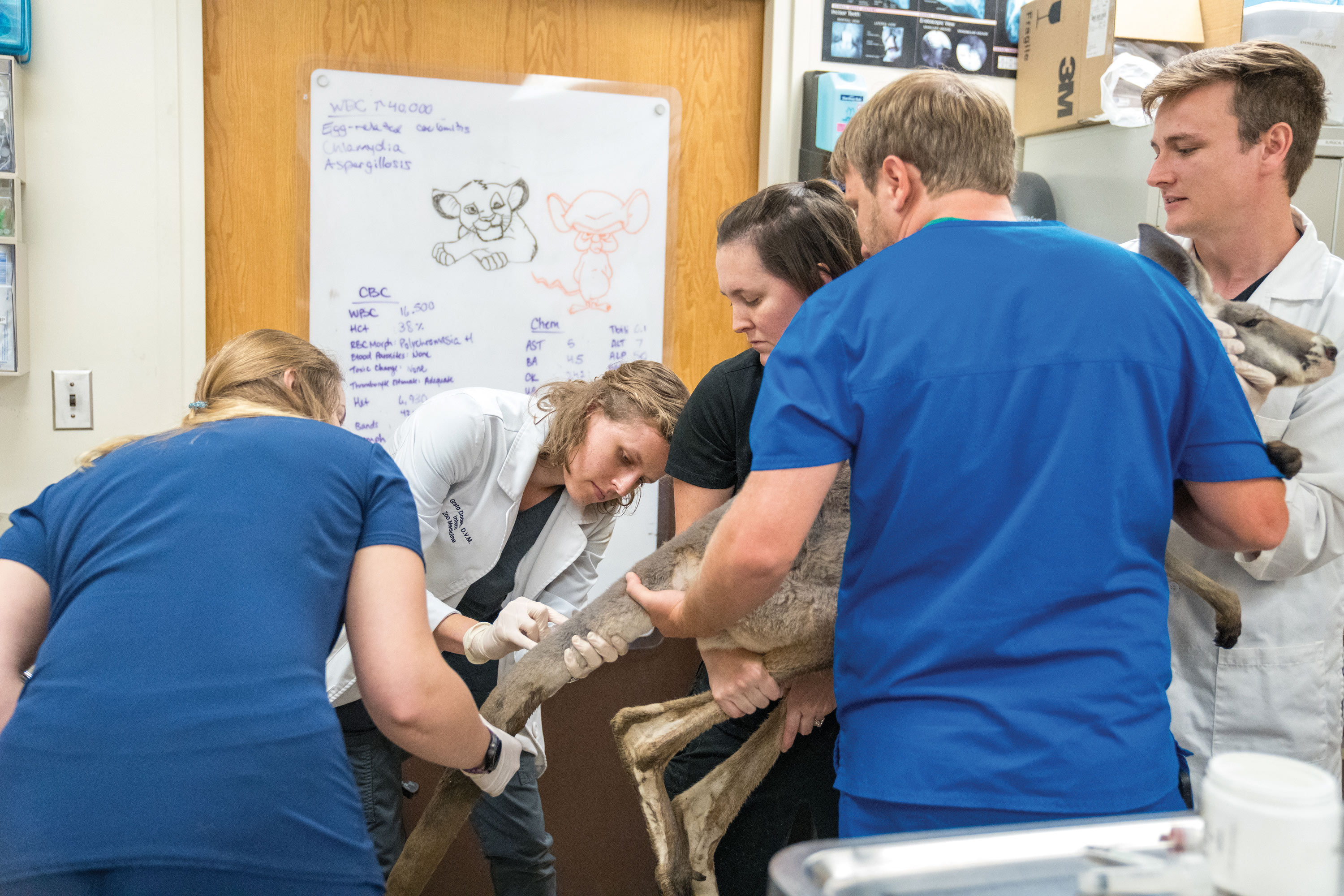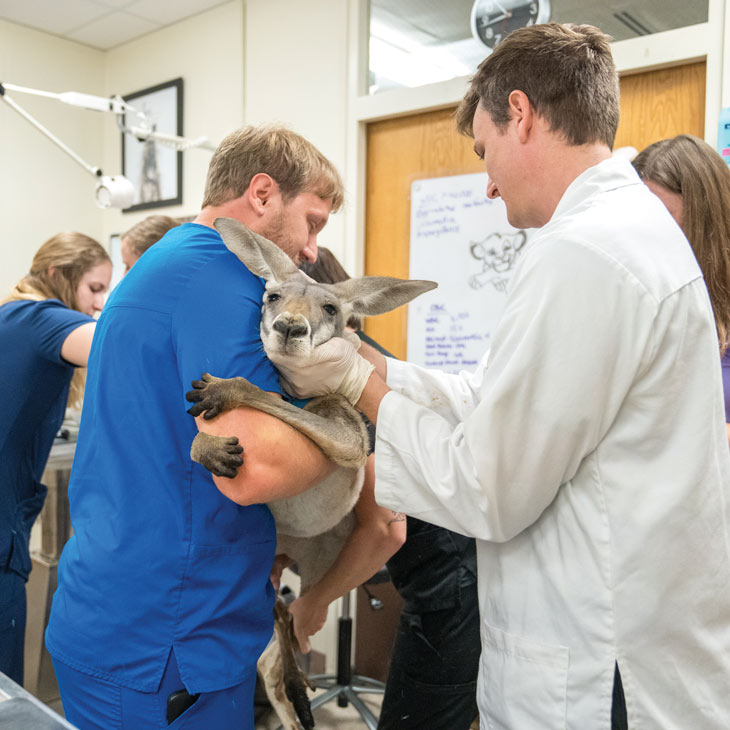
Hops for Healing: OSU vet med's zoological medicine team treats two kangaroos
Friday, January 19, 2024
Media Contact: Taylor Bacon | Public Relations and Marketing Coordinator | 405-744-6728 | taylor.bacon@okstate.edu
Not every animal that gets treated in Stillwater is from Oklahoma, or even North America.
Oklahoma State University’s Veterinary Medical Teaching Hospital zoological medicine team recently had the opportunity to learn and work with animals they don’t see every day.
Since April 2022, Karen Smith has brought her kangaroos to the VMTH for care. The first patient she brought. to OSU was a male red kangaroo named Rip. His most recent health concern was a dislocated hip, which left him in the care of hospital faculty and staff for eight days.

“We first took him to our local vet who X-rayed him and referred us to OSU,” Smith said.
Rip presented severely lame and, after radiographs were taken, they showed he had a coxofemoral luxation.
“When Rip came to us, we initially tried to replace the luxation manually with him under anesthesia, however, that was not possible,” said Dr. João Brandão, associate professor of zoological medicine and Debbie and Wayne Bell professor in veterinary clinical sciences. “Therefore, surgical repair was elected.”
After recovering from surgery, Rip is back home and doing great, said zoological medicine intern Dr. Greta Doden.
“The collaboration between all of the services: zoo medicine, surgery, anesthesia and ICU/critical care was the main reason for his success,” Doden said.
After seeing how Rip did in treatment, Smith decided to use OSU again when her 1.5-year-old male red kangaroo, Ozzie, had an issue in October 2023.
“I first noticed something was wrong when he didn’t come to dinner like usual,” Smith said.
Ozzie was lethargic, had a reduced appetite and exhibited dark-colored urine. He was hospitalized for seven days and received numerous tests.
“I was very excited when I found out we would have a kangaroo coming to the clinic. It was also a little nerveracking because I have only ever seen kangaroos in the zoo.”
“His initial exam was unremarkable, so bloodwork was performed for further health assessment,” Doden said. “His liver values were elevated, so many other tests were performed.”
Ozzie received a CT scan, ultrasound, urine and fecal testing, liver biopsy, and other blood tests including those for copper levels, Toxoplasma titers and other infectious disease tests.
“Despite all of these diagnostics, we were unable to definitively diagnose the cause of his liver disease,” Doden said. “However, we were most suspicious of toxoplasma infection or toxin ingestion.”

Toxoplasma is very common in kangaroos and causes severe illness, but is difficult to detect. Doden said Ozzie received toxoplasma treatment for many weeks and his bloodwork returned to normal a few weeks later.
“He was discharged for further care at home and his owner meticulously removed any potentially toxic plants from his enclosure,” Doden said. “He has been doing great at home and has been reintroduced to his kangaroo and wallaby pen mates.”
It’s not every day the zoological medicine team is given the opportunity to work with kangaroos. Therefore, Ozzie and Rip’s cases have provided a great learning experience for CVM students.
With unique cases like the marsupials, students had mixed feelings going into the process of treating Ozzie and Rip. Dylan Lucich, a fourth-year veterinary student, said his first line of thinking was how exciting it would be to work with the exotic animals, but those thoughts were followed by many questions about kangaroo care.
Lucich said since they are not like most animals you see in North America, he was wondering how one might restrain them or draw blood for their exams. He even wondered how aggressive the marsupials might be.
So, preparing for Ozzie’s arrival consisted of a lot of studying.
“I dove into as much research as I could about kangaroo lifestyle, husbandry and care prior to Ozzie showing up,” Lucich said.
Tending to a species that isn’t common in Oklahoma can be overwhelming for students.

“I was very excited when I found out we would have a kangaroo coming to the clinic,” said Julianne Wallace, fourth-year veterinary student. “It was also a little nerve-racking because I have only ever seen kangaroos in the zoo.”
Although the cases may have made the students anxious at first, most of them were eager to work with a kangaroo.
“I actually requested to be on Ozzie’s case when I saw him on the schedule,” said Kaitlyn Cole, fourth-year veterinary student. “I practically begged my classmates on the rotation with me to let me be on this case because Ithought it would be super interesting.”
Students gained experience working with different kangaroo temperaments.
“I learned that very rarely do exotic animal appointments go as planned and you must be prepared to pivot to get done what you need to,” Cole said. “It’s very difficult to get a kangaroo to do something they don’t want to, even with all the people we had around to help.”
After extensively working with both kangaroos, the zoological medicine team is happy to see both Ozzie and Rip are doing great now.
“Nobody can take care of kangaroos like they do at OSU,” Smith said. “They are just the best, and their care is extraordinary.”
Clients like Smith are greatly appreciated when it comes to learning new information on exotic species. Sometimes, the most unique cases are the ones that offer some of the most insightful experiences.
Photos By: Bailey White
Story By: Bailey White | Vet Cetera Magazine
